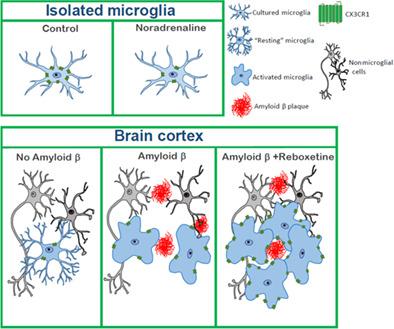Our official English website, www.x-mol.net, welcomes your
feedback! (Note: you will need to create a separate account there.)
Microglial CX3CR1 production increases in Alzheimer's disease and is regulated by noradrenaline.
Glia ( IF 5.4 ) Pub Date : 2020-07-14 , DOI: 10.1002/glia.23885 Marta González-Prieto 1, 2 , Irene L Gutiérrez 1, 2 , Borja García-Bueno 1, 2 , Javier R Caso 1, 2 , Juan C Leza 1, 2 , Adriana Ortega-Hernández 3, 4 , Dulcenombre Gómez-Garre 3, 4 , José L M Madrigal 1, 2
Glia ( IF 5.4 ) Pub Date : 2020-07-14 , DOI: 10.1002/glia.23885 Marta González-Prieto 1, 2 , Irene L Gutiérrez 1, 2 , Borja García-Bueno 1, 2 , Javier R Caso 1, 2 , Juan C Leza 1, 2 , Adriana Ortega-Hernández 3, 4 , Dulcenombre Gómez-Garre 3, 4 , José L M Madrigal 1, 2
Affiliation

|
The loss of noradrenergic neurons and subsequent reduction of brain noradrenaline (NA) levels are associated with the progression of Alzheimer's disease (AD). This seems to be due mainly to the ability of NA to reduce the activation of microglial cells. We previously observed that NA induces the production of the chemokine Fractalkine/CX3CL1 in neurons. The activation of microglial CX3CR1, sole receptor for CX3CL1, reduces the activation of microglia, which is known to largely contribute to the neuronal damage characteristic of AD. Therefore, alterations of CX3CR1 production in microglia could translate into the enhancement or inhibition of CX3CL1 anti‐inflammatory effects. In order to determine if microglial CX3CR1 production is altered in AD and if NA can control it, CX3CR1 expression and synthesis were analyzed in 5xFAD mice and human AD brain samples. In addition, the effects of NA and its reuptake inhibitor reboxetine were analyzed in microglial cultures and mice respectively. Our results indicate that in AD CX3CR1 production is increased in the brain cortex and that reboxetine administration further increases it and enhances microglial reactivity toward amyloid beta plaques. However, direct administration of NA to primary rat microglia or human HMC3 cells inhibits CX3CR1 production, suggesting that microglia responses to NA may be altered in the absence of CX3CL1‐producing neurons or other nonmicroglial external factors.
中文翻译:

小胶质细胞 CX3CR1 的产生在阿尔茨海默病中增加,并受去甲肾上腺素的调节。
去甲肾上腺素能神经元的丧失和随后脑去甲肾上腺素 (NA) 水平的降低与阿尔茨海默病 (AD) 的进展有关。这似乎主要是由于 NA 能够减少小胶质细胞的活化。我们之前观察到 NA 诱导神经元中趋化因子 Fractalkine/CX3CL1 的产生。小胶质细胞 CX3CR1(CX3CL1 的唯一受体)的激活降低了小胶质细胞的激活,已知这在很大程度上促成了 AD 的神经元损伤特征。因此,小胶质细胞中 CX3CR1 产生的改变可以转化为 CX3CL1 抗炎作用的增强或抑制。为了确定 AD 中小胶质细胞 CX3CR1 的产生是否改变以及 NA 是否可以控制它,在 5xFAD 小鼠和人类 AD 脑样本中分析了 CX3CR1 的表达和合成。此外,分别在小胶质细胞培养物和小鼠中分析了 NA 及其再摄取抑制剂瑞波西汀的作用。我们的研究结果表明,在 AD 中,大脑皮层中 CX3CR1 的产生增加,并且瑞波西汀给药进一步增加了它并增强了小胶质细胞对淀粉样蛋白 β 斑块的反应性。然而,直接向原代大鼠小胶质细胞或人 HMC3 细胞施用 NA 会抑制 CX3CR1 的产生,这表明在没有产生 CX3CL1 的神经元或其他非小胶质细胞外部因素的情况下,小胶质细胞对 NA 的反应可能会发生改变。我们的研究结果表明,在 AD 中,大脑皮层中 CX3CR1 的产生增加,并且瑞波西汀给药进一步增加了它并增强了小胶质细胞对淀粉样蛋白 β 斑块的反应性。然而,直接向原代大鼠小胶质细胞或人 HMC3 细胞施用 NA 会抑制 CX3CR1 的产生,这表明在没有产生 CX3CL1 的神经元或其他非小胶质细胞外部因素的情况下,小胶质细胞对 NA 的反应可能会发生改变。我们的研究结果表明,在 AD 中,大脑皮层中 CX3CR1 的产生增加,并且瑞波西汀给药进一步增加了它并增强了小胶质细胞对淀粉样蛋白 β 斑块的反应性。然而,直接向原代大鼠小胶质细胞或人 HMC3 细胞施用 NA 会抑制 CX3CR1 的产生,这表明在没有产生 CX3CL1 的神经元或其他非小胶质细胞外部因素的情况下,小胶质细胞对 NA 的反应可能会发生改变。
更新日期:2020-07-14
中文翻译:

小胶质细胞 CX3CR1 的产生在阿尔茨海默病中增加,并受去甲肾上腺素的调节。
去甲肾上腺素能神经元的丧失和随后脑去甲肾上腺素 (NA) 水平的降低与阿尔茨海默病 (AD) 的进展有关。这似乎主要是由于 NA 能够减少小胶质细胞的活化。我们之前观察到 NA 诱导神经元中趋化因子 Fractalkine/CX3CL1 的产生。小胶质细胞 CX3CR1(CX3CL1 的唯一受体)的激活降低了小胶质细胞的激活,已知这在很大程度上促成了 AD 的神经元损伤特征。因此,小胶质细胞中 CX3CR1 产生的改变可以转化为 CX3CL1 抗炎作用的增强或抑制。为了确定 AD 中小胶质细胞 CX3CR1 的产生是否改变以及 NA 是否可以控制它,在 5xFAD 小鼠和人类 AD 脑样本中分析了 CX3CR1 的表达和合成。此外,分别在小胶质细胞培养物和小鼠中分析了 NA 及其再摄取抑制剂瑞波西汀的作用。我们的研究结果表明,在 AD 中,大脑皮层中 CX3CR1 的产生增加,并且瑞波西汀给药进一步增加了它并增强了小胶质细胞对淀粉样蛋白 β 斑块的反应性。然而,直接向原代大鼠小胶质细胞或人 HMC3 细胞施用 NA 会抑制 CX3CR1 的产生,这表明在没有产生 CX3CL1 的神经元或其他非小胶质细胞外部因素的情况下,小胶质细胞对 NA 的反应可能会发生改变。我们的研究结果表明,在 AD 中,大脑皮层中 CX3CR1 的产生增加,并且瑞波西汀给药进一步增加了它并增强了小胶质细胞对淀粉样蛋白 β 斑块的反应性。然而,直接向原代大鼠小胶质细胞或人 HMC3 细胞施用 NA 会抑制 CX3CR1 的产生,这表明在没有产生 CX3CL1 的神经元或其他非小胶质细胞外部因素的情况下,小胶质细胞对 NA 的反应可能会发生改变。我们的研究结果表明,在 AD 中,大脑皮层中 CX3CR1 的产生增加,并且瑞波西汀给药进一步增加了它并增强了小胶质细胞对淀粉样蛋白 β 斑块的反应性。然而,直接向原代大鼠小胶质细胞或人 HMC3 细胞施用 NA 会抑制 CX3CR1 的产生,这表明在没有产生 CX3CL1 的神经元或其他非小胶质细胞外部因素的情况下,小胶质细胞对 NA 的反应可能会发生改变。











































 京公网安备 11010802027423号
京公网安备 11010802027423号